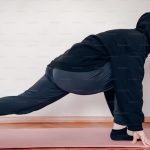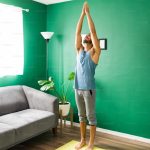Handstands are one of those wonderfully iconic poses of yoga, isn’t it? Done well it is a graceful combination of strength, balance and poise — a challenging, dynamic inversion and pure poetry in motion, but I know I am not alone in struggling to master even a few moments in handstand before gravity takes over and I crumple into an untidy heap. So, is it just that I need more practice? Or is my anatomy getting in the way?
What is the Perfect Handstand?
Lets start off by thinking about the full expression of the pose – what do we need to achieve? Our body needs to be able to get into a straight line with feet, pelvis, shoulders and wrists all in line. Our wrists need to be able to extend (bend backwards) and be able to bear our full body weight. Then we need the core and upper body strength to hold this position against gravity while maintaining perfect balance.
So our joints need to be able to get into position. That means 90 degree wrist extension, 180 degree shoulder flexion, normal spinal alignment and neutral hip extension. A limitation in any one of these aspects of the pose will get in the way of the perfect handstand.
See Also: 6 Tips to Teaching Arm Balances in Class
The Anatomy of a Hanstand
There are lots of things that can limit range of movement around a joint:
- Bony architecture — Though nature works on a common design for each of our joints, there are differences between individuals that determine what our maximum range of motion at a joint can be. Some people’s wrists will never achieve the range of extension needed for a handstand because the bones of their forearm and those of the wrist impinge (or jam against each other) when the wrist extends. This can’t be changed with practice, it is just a fact of life.
- Inert soft tissues — Every joint is held together by soft tissues (e.g. joint capsules and ligaments) that act as guy ropes on the joint and prevent it from moving too far in any one direction. These are made up of tough gristle and are a little bit elastic. If these tissues don’t get taken to a full stretch regularly they start to shorten and become less elastic, limiting the range of motion at that joint. It really is a case of, “If you don’t use it you lose it.” The good news here is that these changes are prevented or reversed every time you roll out your mat to practice.
- Contractile units — These are the muscles and tendons of the body that can also be too short to allow joints to get to their optimum range of movement. For handstand this is particularly relevant in the wrist flexors (on the palm side of the forearm), the front of the shoulder and the front of the hips. And this is where targeted stretching during asana really reaps rewards for anyone striving for the perfect handstand.
- Fascia — This is my current favourite soft tissue of the body. Fascia is a thin, mesh-like fine tissue paper that is present throughout the musculoskeletal system. It basically holds us together and provides support, communication and nutrition. It links our inert soft tissues and contractile units in fascial planes that run from head to toe and finger tips. Asana is the best way I know of gaining length and mobility in our fascia.
The Strength of Your Practice
As well as having enough range of movement in the joints, we need strength in the muscle groups that are working in a pose. For handstand the most important ones are…
- Wrist and finger flexors pushing the hand against the floor.
- Biceps and triceps working to hold the elbow in a micro bend and avoid locking out into hyperextension.
- Rotator cuff of the shoulder working to stabilise and prevent impingement in the joint.
- Serratus anterior working with the rhomboids and trapezius to stabilise the torso on the arms.
- Core muscles to hold body upright over shoulders.
- Psoas and glutes working with hip adductors to stabilise hips in neutral position and draw the legs together.
- Quads to hold knees straight.
See Also: These 6 Poses Make An Indispensable Core Workout
The Path to Success
As I said, we can’t change the shape of our bones but we can work to steadily stretch and mobilise our fascia, soft tissues and contractile units while building the strength we need to succeed. Breaking down the pose into elements and working on poses that address the specific limitations will move our practice forwards. Here’s a few things you can try to improve your handstand:
- Pūrvottānāsana (reverse plank) or table top — Pushing into your fingers strengthens the wrist flexors and encourages the stretch through your biceps and anterior shoulder.
- Dolphin — An accessible inversion weight bearing through forearms that strengthens the shoulders and upper back while stretching the shoulders. To ramp it up, float one leg up into a three-legged version and hold for a few breaths to emphasise core strength.
- Crescent lunge — This is a lovely stretch for the anterior fascial plane from finger tips all the way down into the back leg and will help to address tightness in the front of the hips and shoulders. To gain an extra stretch and emphasise leg strength, try dipping the back knee to kiss the floor then straightening both legs together. Repeat a few times to really feel the burn.
- Puppy stretch — Lift hips from Child’s Pose and slide both arms forwards until the thighs are vertical. This is a lovely pose to stretch the front of your shoulders. You can also use this position to practice activating serratus anterior, rhomboids and trapezius muscles to stabilise the shoulder girdle. Or, to increase the fascial element, keep your elbows bent and point your hands to the ceiling as you move into the stretch.
- Planks — High, low and side planks all strengthen the core. Try moving as slowly as possible through your vinyasa or pulse slowly from high plank into down dog and back a few times to wake up your core.
The bottom line is that we aren’t all going to be able to do a handstand at our first attempt, but there is a lot we can do to work towards it if doing a handstand is one of our goals. As you work through the building blocks, enjoy the journey. Savour the smaller successes and build on the foundations of previous achievement as your practice develops. Be patient and kind to yourself in your endeavours. But most of all, remember that you don’t have to be able to do a handstand to be a real yogi and some of us may never get there, but we can have a lot of fun trying!












